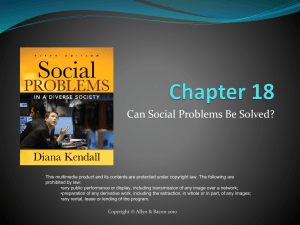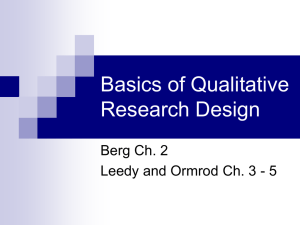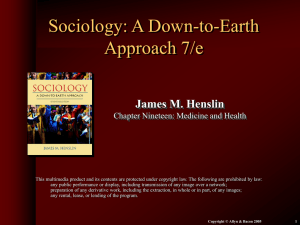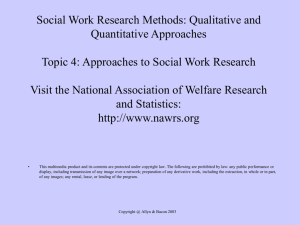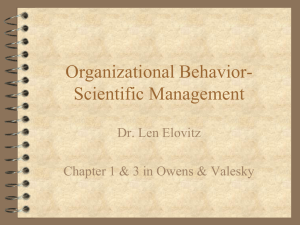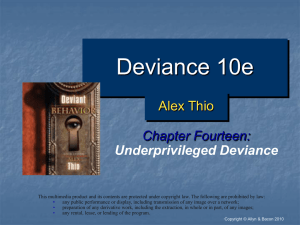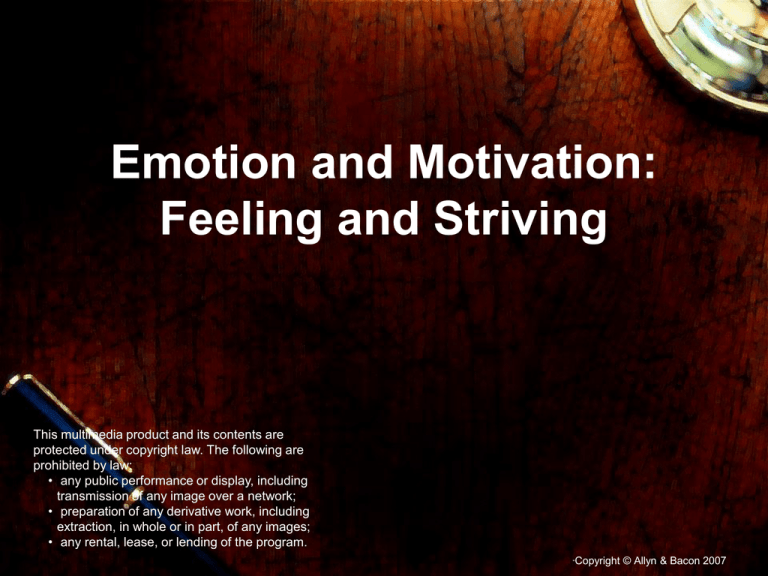
Emotion and Motivation:
Feeling and Striving
This multimedia product and its contents are
protected under copyright law. The following are
prohibited by law:
• any public performance or display, including
transmission of any image over a network;
• preparation of any derivative work, including
extraction, in whole or in part, of any images;
• any rental, lease, or lending of the program.
“
Copyright © Allyn & Bacon 2007
Emotion
• A psychological state with four
components:
– A positive or negative subjective
experience
– The activation of specific mental processes
and stored information
– Bodily arousal
– Characteristic overt behavior
“
Copyright © Allyn & Bacon 2007
Question
This multimedia product and its contents are
protected under copyright law. The following are
prohibited by law:
• any public performance or display, including
transmission of any image over a network;
• preparation of any derivative work, including
extraction, in whole or in part, of any images;
• any rental, lease, or lending of the program.
“
Copyright © Allyn & Bacon 2007
Which of the following is not a
component of emotion?
• A) bodily arousal
• B) a positive or negative subjective
experience
• C) objective feelings.
• D) activation of specific mental processes
• E) characteristic behavior
“
Copyright © Allyn & Bacon 2007
Which of the following is not a
component of emotion?
•
•
•
•
•
A) bodily arousal
B) a positive or negative subjective experience
C) objective feelings.
D) activation of specific mental processes
E) characteristic behavior
“
Copyright © Allyn & Bacon 2007
Name the Emotion
Happy
Sad
Fear
Anger
Surprise
Disgust
“
Copyright © Allyn & Bacon 2007
• Basic emotions
• Controversial
– 3 types of disgust/5 types of positive
“
Copyright © Allyn & Bacon 2007
Are Emotions Universal?
• Does the Fore tribe in New Guinea
identify Caucasian facial expressions?
“
Copyright © Allyn & Bacon 2007
Question
This multimedia product and its contents are
protected under copyright law. The following are
prohibited by law:
• any public performance or display, including
transmission of any image over a network;
• preparation of any derivative work, including
extraction, in whole or in part, of any images;
• any rental, lease, or lending of the program.
“
Copyright © Allyn & Bacon 2007
An innate emotion that all
humans share is called a(n):
•
•
•
•
•
A) universal experience.
B) fundamental feeling.
C) objective experience.
D) basic emotion.
E) expression
“
Copyright © Allyn & Bacon 2007
An innate emotion that all
humans share is called a(n):
•
•
•
•
•
A) universal experience.
B) fundamental feeling.
C) objective experience.
D) basic emotion.
E) expression
“
Copyright © Allyn & Bacon 2007
Separate But Equal
Emotions
• Positive and negative emotions can
coexist
• Approach emotions
– Love and happiness
• Withdrawal emotions
– Fear and disgust
“
Copyright © Allyn & Bacon 2007
Theories of Emotion:
James-Lange Theory
Event
Physiological
arousal
Interpret
physiological
changes
Emotion
You feel emotions after your body reacts
“
Copyright © Allyn & Bacon 2007
Theories of Emotion:
Cannon-Bard Theory
Event
Physiological
arousal
Emotion
The event causes both arousal and emotion
“
Copyright © Allyn & Bacon 2007
Theories of Emotion:
Cognitive Theory
Event
Physiological
arousal
Interpret
based on
context
Emotion
Your arousal and the context
combine to form emotions
“
Copyright © Allyn & Bacon 2007
Theories of Emotion:
Emerging Synthesis
Brain and
body
reactions
Event
Emotion
Memories and
interpretation
Different emotions rely on different
combinations of body and brain reactions
and interpretation
“
Copyright © Allyn & Bacon 2007
Question
This multimedia product and its contents are
protected under copyright law. The following are
prohibited by law:
• any public performance or display, including
transmission of any image over a network;
• preparation of any derivative work, including
extraction, in whole or in part, of any images;
• any rental, lease, or lending of the program.
“
Copyright © Allyn & Bacon 2007
Which theory of emotion states
that your body reacts before you
experience an emotion?
•
•
•
•
•
A) Allport-Cattell
B) Cannon-Bard
C) cognitive
D) Belle-Barrett
E) James-Lange
“
Copyright © Allyn & Bacon 2007
Which theory of emotion states
that your body reacts before you
experience an emotion?
•
•
•
•
•
A) Allport-Cattell
B) Cannon-Bard
C) cognitive
D) Belle-Barrett
E) James-Lange
“
Copyright © Allyn & Bacon 2007
Another Question
This multimedia product and its contents are
protected under copyright law. The following are
prohibited by law:
• any public performance or display, including
transmission of any image over a network;
• preparation of any derivative work, including
extraction, in whole or in part, of any images;
• any rental, lease, or lending of the program.
“
Copyright © Allyn & Bacon 2007
Which is the best explanation
of the Cannon-Bard theory?
• A) Bodily arousal occurs before emotional
response.
• B) Emotions arise from learned triggers.
• C) Emotion is nothing but a reflexive
response based on instincts.
• D) Bodily arousal and emotional experience
occur simultaneously.
• E) Emotions are changes in core affect.
“
Copyright © Allyn & Bacon 2007
Which is the best explanation
of the Cannon-Bard theory?
• A) Bodily arousal occurs before emotional
response.
• B) Emotions arise from learned triggers.
• C) Emotion is nothing but a reflexive
response based on instincts.
• D) Bodily arousal and emotional experience
occur simultaneously.
• E) Emotions are changes in core affect.
“
Copyright © Allyn & Bacon 2007
Facial Feedback
Hypothesis
• We experience emotions in part as a result of
the positions of our facial muscles
– Smiling makes you feel happier
– Frowning makes you feel sadder
“
Copyright © Allyn & Bacon 2007
The Schacter-Singer
Experiment
• Participants are told they are receiving a
vitamin supplement
• They actually receive epinephrine
“
Copyright © Allyn & Bacon 2007
The Schacter-Singer Experiment
Emotional response depended on context
Misattribution of arousal
“
Copyright © Allyn & Bacon 2007
Fear
• Four basic facts about fear
– Fear can be an emotional reflex
– Fear can be classically conditioned
– Fear interacts with mental processes
– The amygdala does not play a role in
producing the emotional “feel” of fear
“
Copyright © Allyn & Bacon 2007
Question
This multimedia product and its contents are
protected under copyright law. The following are
prohibited by law:
• any public performance or display, including
transmission of any image over a network;
• preparation of any derivative work, including
extraction, in whole or in part, of any images;
• any rental, lease, or lending of the program.
“
Copyright © Allyn & Bacon 2007
It is possible to interpret bodily
arousal incorrectly. When this
happens, it is called:
•
•
•
•
•
A) misattribution of arousal.
B) interpretive error.
C) misapplication of arousal.
D) cognitive restructuring.
E) an affective disorder.
“
Copyright © Allyn & Bacon 2007
It is possible to interpret bodily
arousal incorrectly. When this
happens, it is called:
•
•
•
•
•
A) misattribution of arousal.
B) interpretive error.
C) misapplication of arousal.
D) cognitive restructuring.
E) an affective disorder.
“
Copyright © Allyn & Bacon 2007
Happiness
• Hedonic treadmill-what makes people
happy? $$$?
• Social comparison and happiness
• People with more left frontal lobe
activation tend to be happier
• Happiness promotes resilience
• Immune system boost
“
Copyright © Allyn & Bacon 2007
Question
This multimedia product and its contents are
protected under copyright law. The following are
prohibited by law:
• any public performance or display, including
transmission of any image over a network;
• preparation of any derivative work, including
extraction, in whole or in part, of any images;
• any rental, lease, or lending of the program.
“
Copyright © Allyn & Bacon 2007
• Darius inherited $500,000 from his
grandmother. He bought a new house and a
new car and then spent the rest on vacations
and new furnishings for the house. Although
he is happier, that is likely to fade in a
relatively short period of time. This is called
________.
• A) greener grass syndrome
• B) the squirrel cage
• C) the hedonic treadmill
• D) mice and maze phenomenon
• E) financial feedback hypothesis
“
Copyright © Allyn & Bacon 2007
• Darius inherited $500,000 from his
grandmother. He bought a new house and a
new car and then spent the rest on vacations
and new furnishings for the house. Although
he is happier, that is likely to fade in a
relatively short period of time. This is called
________.
• A) greener grass syndrome
• B) the squirrel cage
• C) the hedonic treadmill
• D) mice and maze phenomenon
• E) financial feedback hypothesis
“
Copyright © Allyn & Bacon 2007
•
•
•
•
China-social support and happiness
Culture and happiness
Happy people and self-comparisons
Personality and happiness
– Assertive
– Extraverted
• 50% of happiness is hereditary
“
Copyright © Allyn & Bacon 2007
Expressing Emotion
• Cultural display rules
– Japanese vs. westerners
– Berkeley experiment-watch video
• Body language
– Nonverbal communication
– Gender differences
– Role in conveying sexual interest
– Victims
“
Copyright © Allyn & Bacon 2007
Self-control
• Can you control your emotions?
• Erotic videos
• Those who can suppress can’t enhance
and vice versa
• Whites viewing pictures of black and
white faces
• Imitate other’s emotions
“
Copyright © Allyn & Bacon 2007
Question
This multimedia product and its contents are
protected under copyright law. The following are
prohibited by law:
• any public performance or display, including
transmission of any image over a network;
• preparation of any derivative work, including
extraction, in whole or in part, of any images;
• any rental, lease, or lending of the program.
“
Copyright © Allyn & Bacon 2007
• Researchers suggest that at least
________ of the variability in happiness
may be the result of heredity.
• A) only 25%
• B) at least 60%
• C) about 50%
• D) less than 10%
“
Copyright © Allyn & Bacon 2007
• Researchers suggest that at least
________ of the variability in happiness
may be the result of heredity.
• A) only 25%
• B) at least 60%
• C) less than 50%
• D) at least 50%
• E) less than 10%
“
Copyright © Allyn & Bacon 2007
Motivation
The requirements and desires that
lead animals (including humans) to
behave in a particular way at a
particular time and place
“
Copyright © Allyn & Bacon 2007
• The requirements and desires that lead
humans and other animals to behave in
particular ways at particular times and
places are called ________.
• A) motivations
• B) drives
• C) wishes
• D) instincts
• E) incentives
“
Copyright © Allyn & Bacon 2007
• The requirements and desires that lead
humans and other animals to behave in
particular ways at particular times and
places are called ________.
• A) motivations
• B) drives
• C) wishes
• D) instincts
• E) incentives
“
Copyright © Allyn & Bacon 2007
Theories of Motivation:
Instincts
Organisms have inherited tendencies to
produce organized and unalterable
responses to particular stimuli
• Weakness
– Human behaviors are more complex and flexible
than instincts can explain
• Evolutionary psychology
– Hard-wired goals
“
Copyright © Allyn & Bacon 2007
Theories of Motivation:
Drive
In response to internal imbalances, drives
push you to reduce the imbalance
• Homeostasis-the kid who ate salt
• Weakness
– Assumes the goal is homeostasis, but sometimes
people seek increased or decreased arousal
“
Copyright © Allyn & Bacon 2007
Question
This multimedia product and its contents are
protected under copyright law. The following are
prohibited by law:
• any public performance or display, including
transmission of any image over a network;
• preparation of any derivative work, including
extraction, in whole or in part, of any images;
• any rental, lease, or lending of the program.
“
Copyright © Allyn & Bacon 2007
• An internal imbalance that motivates
humans and other animals to achieve a
goal that will reduce the imbalance is
called a(n):
• A) instinct
• B) drive
• C) motive cue
• D) genetic trigger
• E) affect
“
Copyright © Allyn & Bacon 2007
• An internal imbalance that motivates
humans and other animals to achieve a
goal that will reduce the imbalance is
called a(n):
• A) instinct
• B) drive
• C) motive cue
• D) genetic trigger
• E) affect
“
Copyright © Allyn & Bacon 2007
Theories of Motivation:
Arousal Theory
We seek intermediate levels of
stimulation: when understimulated, we
seek arousal; when overstimulated, we
seek less stimulation
• Weakness
– Difficult to define levels of stimulation and
how they vary
“
Copyright © Allyn & Bacon 2007
Performance Level
The Yerkes-Dodson Law
High
Intermediate
Low
Low
Intermediate
High
Arousal Level
“
Copyright © Allyn & Bacon 2007
Theories of Motivation:
Incentives
We are motivated toward particular goals
in anticipation of a reward
“
Copyright © Allyn & Bacon 2007
•
•
•
•
HS grad - $37,000
Associate’s-$46,000
Bachelor’s- $65,000
Advanced- $88,000
“
Copyright © Allyn & Bacon 2007
Question
This multimedia product and its contents are
protected under copyright law. The following are
prohibited by law:
• any public performance or display, including
transmission of any image over a network;
• preparation of any derivative work, including
extraction, in whole or in part, of any images;
• any rental, lease, or lending of the program.
“
Copyright © Allyn & Bacon 2007
• People tend to perform best at
________ levels of arousal.
• A) low
• B) intermediate
• C) high
• D) variable
• E) extreme
“
Copyright © Allyn & Bacon 2007
• People tend to perform best at
________ levels of arousal.
• A) low
• B) intermediate
• C) high
• D) variable
• E) extreme
“
Copyright © Allyn & Bacon 2007
Theories of Motivation:
Learned Helplessness
Condition that occurs after an animal has
an aversive experience in which nothing it
does can affect what happens to it, and so
it simply gives up and stops trying to
change the situation or to escape
“
Copyright © Allyn & Bacon 2007
Question
This multimedia product and its contents are
protected under copyright law. The following are
prohibited by law:
• any public performance or display, including
transmission of any image over a network;
• preparation of any derivative work, including
extraction, in whole or in part, of any images;
• any rental, lease, or lending of the program.
“
Copyright © Allyn & Bacon 2007
• Manuel had a personality conflict with his
math teacher. No matter how hard he tried to
get along, the teacher seemed to single him
out. Eventually Manuel just quit trying to get
along. He knew it would never help and he
just didn't see the point anymore. Manuel's
feelings are best described as an example of
________ .
• A) classical conditioning
• B) the carrot and the stick
• C) aversion conditioning
• D) an exaggerated focus
• E) learned helplessness
“
Copyright © Allyn & Bacon 2007
• Manuel had a personality conflict with his
math teacher. No matter how hard he tried to
get along, the teacher seemed to single him
out. Eventually Manuel just quit trying to get
along. He knew it would never help and he
just didn't see the point anymore. Manuel's
feelings are best described as an example of
________ .
• A) classical conditioning
• B) the carrot and the stick
• C) aversion conditioning
• D) an exaggerated focus
• E) learned helplessness
“
Copyright © Allyn & Bacon 2007
Needs and Wants
• Need
– A condition that arises from the lack of a
requirement
• Want
– A condition that arises when you have an
unmet goal that will not fill a requirement
“
Copyright © Allyn & Bacon 2007
Needs and Wants
• Types of rewards
– Deprived reward
– Nondeprived reward
“
Copyright © Allyn & Bacon 2007
Wanting something is
not the same thing as
liking it.
“
Copyright © Allyn & Bacon 2007
Types of needs
1) To be competent.
2) To be autonomous.
3) To have social approval.
4) To be dominant or in control.
5) To be affiliated with others.
6) To be powerful.
7) To reach closure.
8) To understand.
9) To maintain self-esteem.
10) To find the world benevolent.
“
Copyright © Allyn & Bacon 2007
Maslow’s Hierarchy of
Needs
Selfactualization
needs
Aesthetic needs
Cognitive needs
Esteem needs
Belongingness needs
Safety needs
Physiological needs
“
Copyright © Allyn & Bacon 2007
Self-Actualization
• “We may expect that a new
discontent and restlessness
will soon develop, unless the
individual is doing what he’s
fitted for. A musician must
make music, an artist must
paint, a poet must write, if he
is to be ultimately at peace.
What a person can be, he
must be. This need we call
self-actualization.”~Maslow
“
Copyright © Allyn & Bacon 2007
Question
This multimedia product and its contents are
protected under copyright law. The following are
prohibited by law:
• any public performance or display, including
transmission of any image over a network;
• preparation of any derivative work, including
extraction, in whole or in part, of any images;
• any rental, lease, or lending of the program.
“
Copyright © Allyn & Bacon 2007
• In Maslow's hierarchy of needs, which of the
following needs is a higher order need than
cognitive needs?
• A) belongingness needs
• B) esteem needs
• C) aesthetic needs
• D) safety needs
• E) physiological needs
“
Copyright © Allyn & Bacon 2007
• In Maslow's hierarchy of needs, which of the
following needs is a higher order need than
cognitive needs?
• A) belongingness needs
• B) esteem needs
• C) aesthetic needs
• D) safety needs
• E) physiological needs
“
Copyright © Allyn & Bacon 2007
Achievement and Culture
• Individualist culture
• Collectivist culture
• Achievement motivation
“
Copyright © Allyn & Bacon 2007
Sexual Behavior
• Reproductive sex
– 2% of sex acts
• Recreational sex
– 98% of sex acts
• Difficult to study
– Sampling bias
– Response bias
“
Copyright © Allyn & Bacon 2007
Sexual Response Cycle
•
•
•
•
Excitement
Plateau
Orgasm
Resolution
– Refractory period (men)
“
Copyright © Allyn & Bacon 2007
“
Copyright © Allyn & Bacon 2007
The Role of Chemicals
• Hormones
– Androgens
• Testosterone
– Estrogens
• Pheromones
“
Copyright © Allyn & Bacon 2007
QuickTime™ and a
decompressor
are needed to see this picture.
“
Copyright © Allyn & Bacon 2007
• Ovulation and eroticism
– About to ovulate=Increased sexual
fantasies
– Increased pheremone production
– Increased sense of smell
“
Copyright © Allyn & Bacon 2007
“
Copyright © Allyn & Bacon 2007
– Prefer “ruggedly
handsome”
• Men’s shifting
hormones
– Anticipation increase
– Married men = lower
testosterone at end of
day
– More time with wife =
lower testosterone
• Oxytocin
“
Copyright © Allyn & Bacon 2007
Sexual Stimuli
• Visual stimuli
– Men more aroused than women
– Nature of video (audience)
– Less important for women
• Olfactory stimuli
• Mating preferences: evolutionary theories
– Parental investment
– Concerns about infidelity
• Adolescents-early sex if friends do it
“
Copyright © Allyn & Bacon 2007
Sexual Orientation
• Heterosexual
• Homosexual 4-10%
– DSM
• Bisexual
• Biological differences
– Hypothalamus
– Genes
• Environment
“
Copyright © Allyn & Bacon 2007
What’s Normal?
• Cultural variations
• Sexual dysfunction
– Male erectile dysfunction
– Female arousal dysfunction
• Atypical sexual behavior: Paraphilias
– Pedophile
– Fetishes
– Transvestism
• “Homophobia”
“
Copyright © Allyn & Bacon 2007
“
Copyright © Allyn & Bacon 2007
“
Copyright © Allyn & Bacon 2007
“
Copyright © Allyn & Bacon 2007




